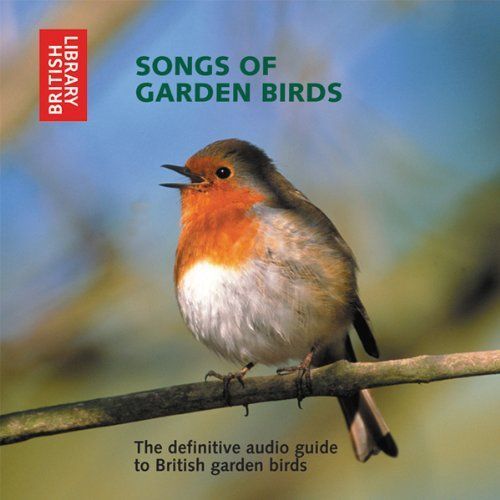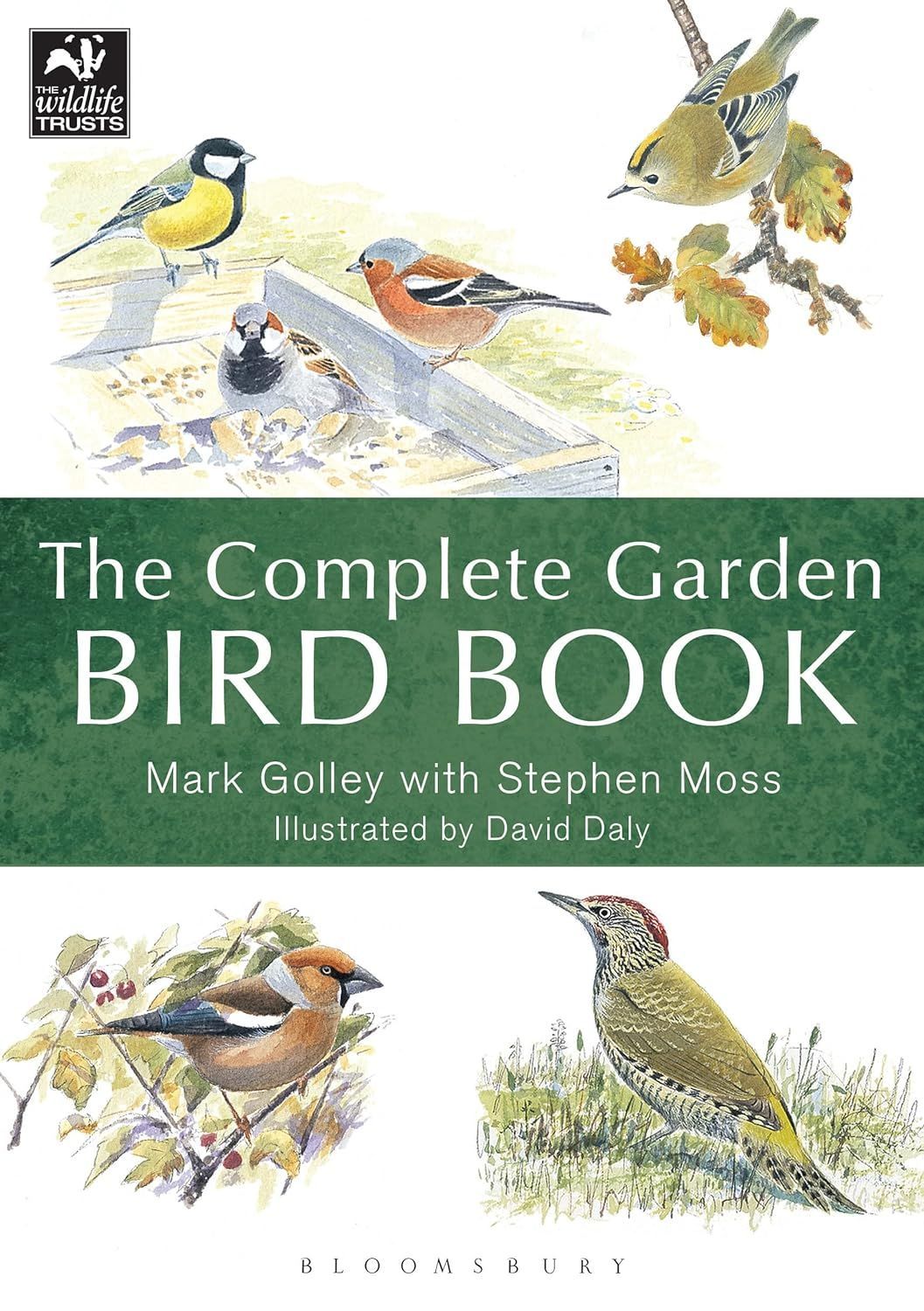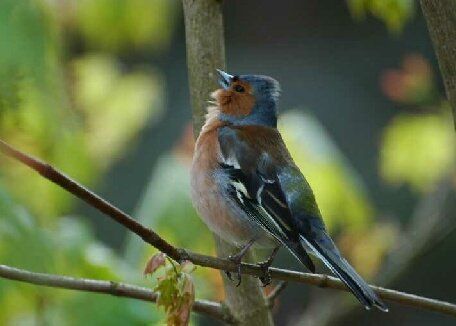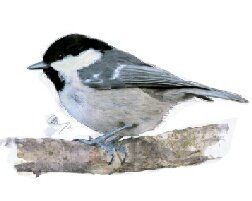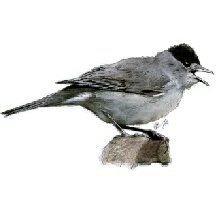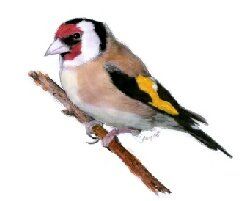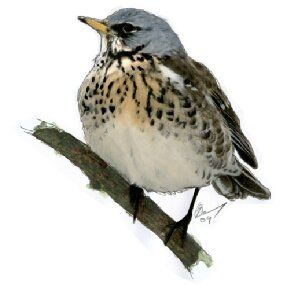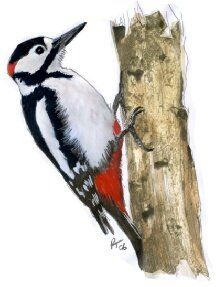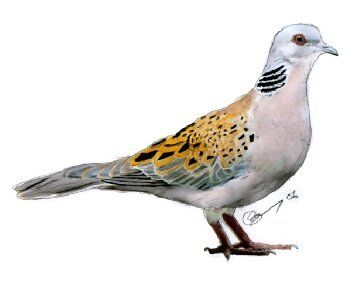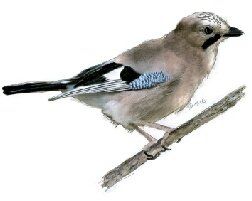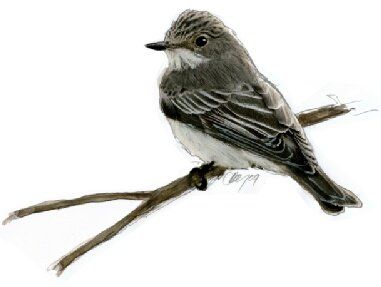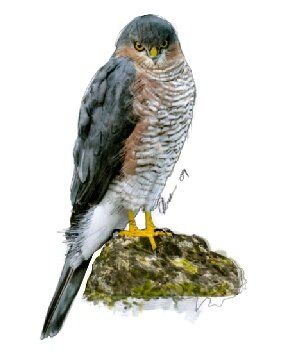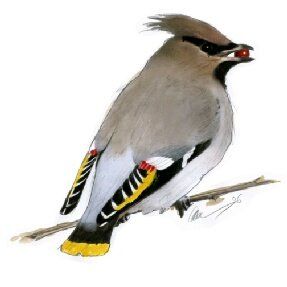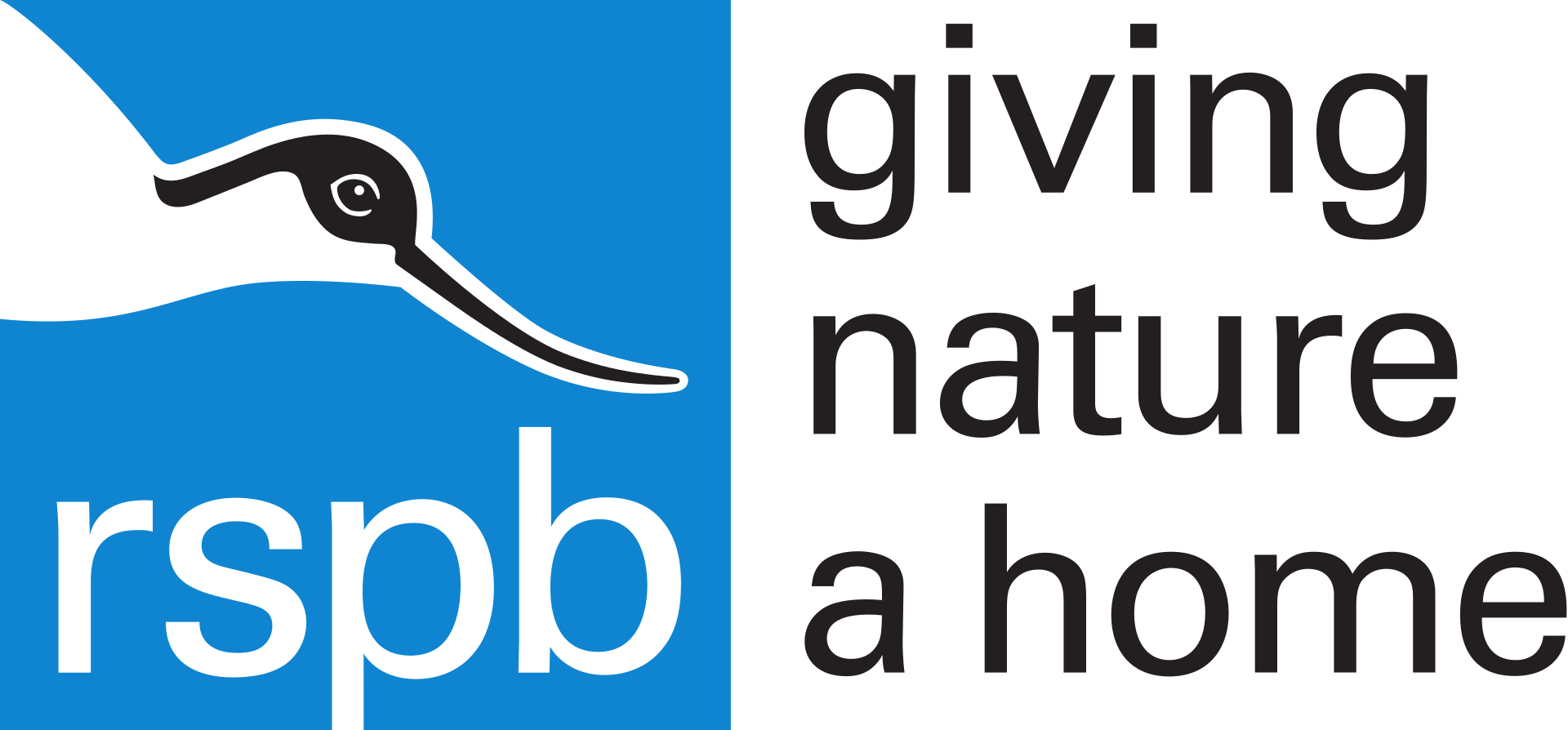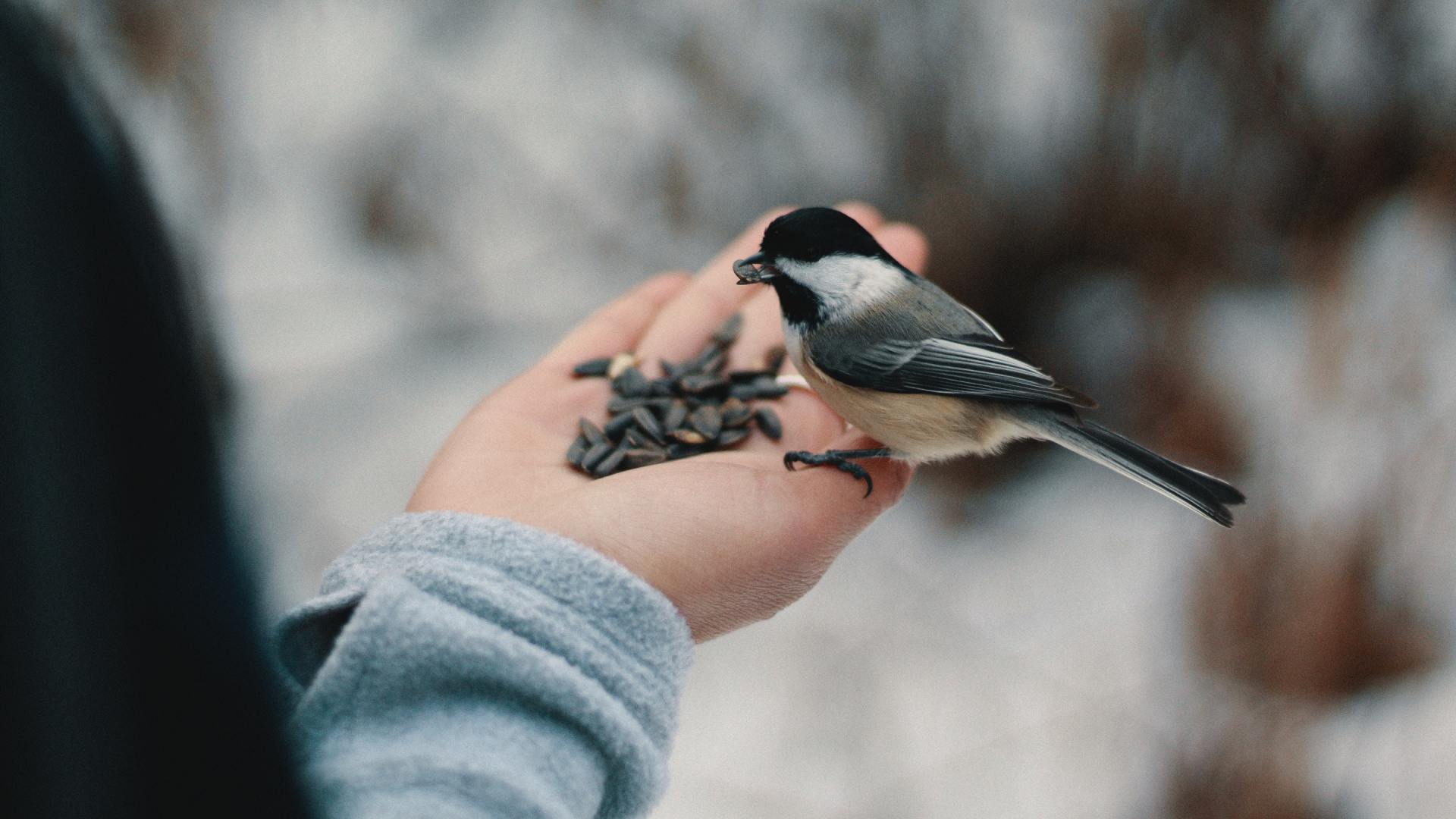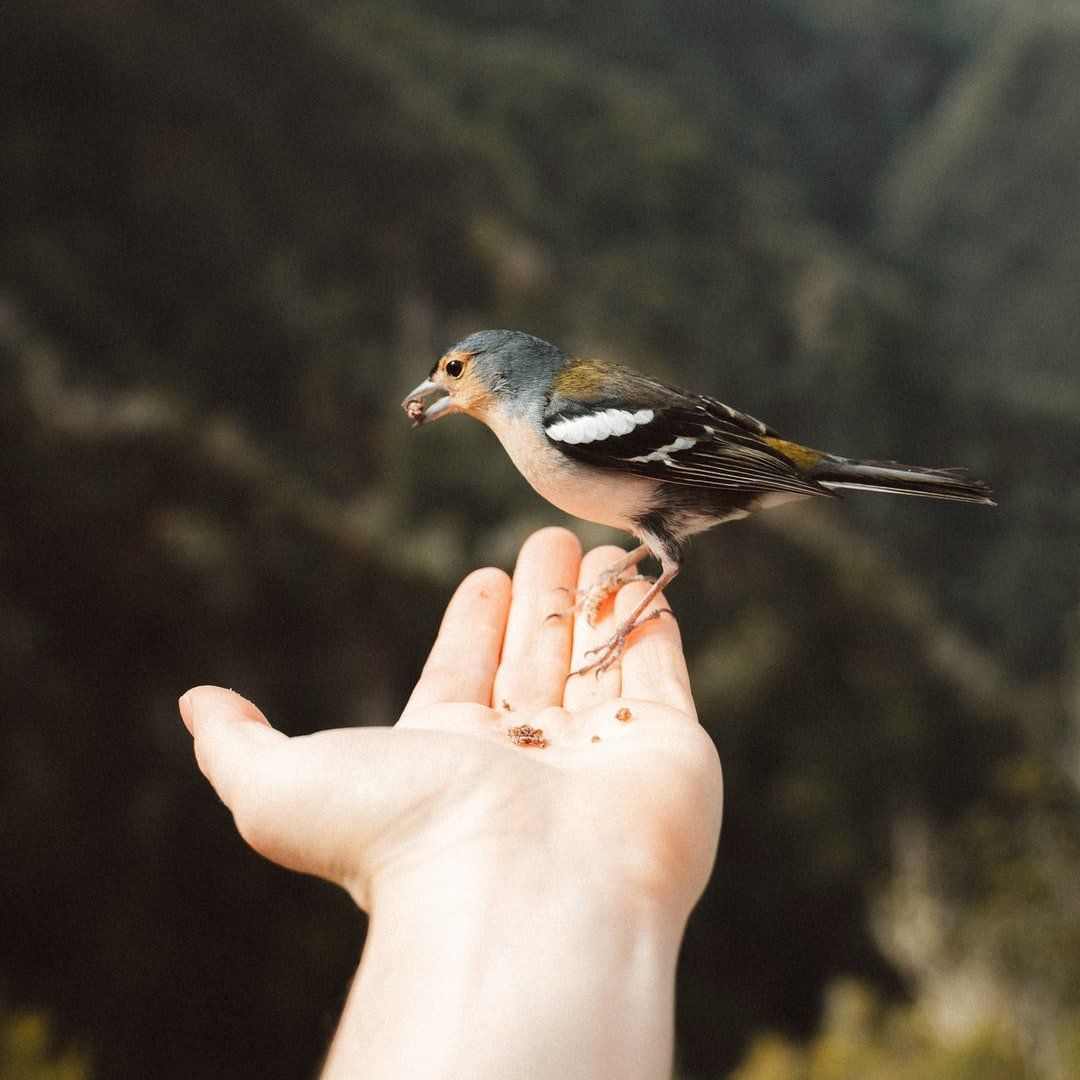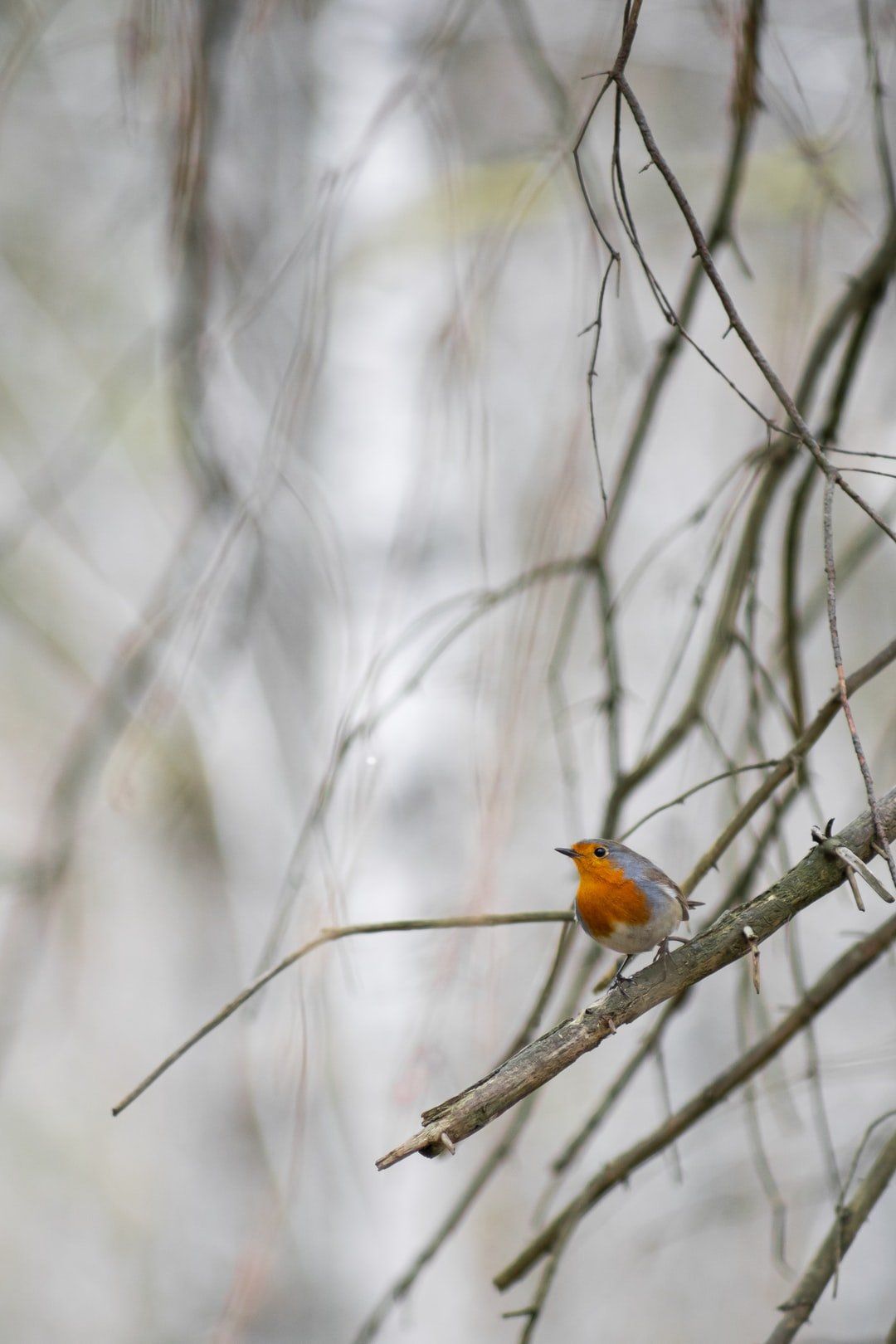
Free birdwatching magazine and guide to finding birds
A very popular audio guide which helps to identify the bids that come to our gardens- not just the early morning minstrels that wake us with their songs, but all those that sing around our homes at any time. Features recordings of the typical songs and calls of the fifty-two species most commonly found in British gardens. This CD presents an introduction to learning and identifying bird sounds in your garden. Includes an introductory booklet. Track listing Track Listing: 1 House Sparrow 2 Starling 3 Blackbird 4 Song Thrush 5 Mistle Thrush 6 Blue Tit 7 Great Tit 8 Coal Tit 9 Marsh Tit 10 Long-tailed Tit 11 Greenfinch 12 Goldfinch 13 Chaffinch 14 Robin 15 Dunnock 16 Wren 17 Feral Pigeon 18 Wood Pigeon 19 Collared Dove 20 Magpie 21 Jay 22 Carrion Crow 23 Rook 24 Jackdaw 25 Great Spotted Woodpecker 26 Green Woodpecker 27 Sparrowhawk 28 House Martin 29 Swallow 30 Pied Wagtail 31 Nuthatch 32 Treecreeper 33 Goldcrest 34 Spotted Flycatcher 35 Blackcap 36 Chiffchaff 37 Willow Warbler 38 Bullfinch 39 Siskin 40 Brambling 41 Black-headed Gull 42 Redwing 43 Fieldfare 44 Tree Sparrow 45 Reed Bunting 46 Yellowhammer 47 Pheasant 48 Rose-ringed Parakeet 49 Swift 50 Canada Goose 51 Herring Gull 52 Tawny Owl
Most of us can tell the difference between a Blue Tit and a Blackbird or a Robin and a Wren, but what happens if you close your eyes – can you still tell which bird is which simply by listening to their song? If the answer is no, then this practical audio guide to the songs of British garden birds is the easy way to get to know the songs of some of our most popular and best-loved songbirds. Recorded on location in the Somerset Levels, in the garden of birdwatcher, writer and broadcaster Stephen Moss, this helpful and practical guide will quickly enable you to sort out your Blue Tits from your Great Tits and your Hedge Sparrows from your Tree Sparrows. Joining Stephen and presenter Brett Westwood, wildlife sound recordist Chris Watson is armed with an array of microphones that allow us to eavesdrop on the songs, calls and alarm cries of the birds we see around us. Packed with useful information and helpful tips, this guide is for anyone who wants to understand more about the beautiful birds which share our parks and gardens every day.
One of the greatest pleasures of having a garden is to be able to observe and identify the great number of different species which may feed, bathe and nest there, or simply fly over, particularly during periods of migration. For the first time, this book combines full identification and behavioural features of over 70 common garden birds as well as detailed, highly-visual information on attracting and encouraging birds to your garden. Stunningly illustrated, yet simple to use, The Complete Garden Bird Book will ensure that you get the maximum pleasure from your garden whatever its size or location.
**SUNDAY TIMES BESTSELLER**
The Garden Jungle is a wonderful introduction to the hundreds of small creatures with whom we
live cheek-by-jowl and of the myriad ways that we can encourage them to thrive.
The Garden Jungle is about the wildlife that lives right under our noses, in our gardens and parks, between the gaps in the pavement, and in the soil beneath our feet. Wherever you are right now, the chances are that there are worms, woodlice, centipedes, flies, silverfish, wasps, beetles, mice, shrews and much, much more, quietly living within just a few paces of you.
Dave Goulson gives us an insight into the fascinating and sometimes weird lives of these creatures, taking us burrowing into the compost heap, digging under the lawn and diving into the garden pond. He explains how our lives and ultimately the fate of humankind are inextricably intertwined with that of earwigs, bees, lacewings and hoverflies, unappreciated heroes of the natural world.
The Garden Jungle is at times an immensely serious book, exploring the environmental harm inadvertently done by gardeners who buy intensively reared plants in disposable plastic pots, sprayed with pesticides and grown in peat cut from the ground. Goulson argues that gardens could become places where we can reconnect with nature and rediscover where food comes from.
How do I attract birds to my garden ?
Short answer is - provide food and shelter, but especially food and especially throughout the winter when natural food can be scarce. Often overlooked is the need to provide water, as even the smallest regular supply will attract birds. If you are not lucky enough to have your own garden, there are bird feeders that can be attached to a window. Try and think of your garden as a private nature reserve and vary the habitat as much as possible, providing areas for birds to feed, drink, roost and breed not overlooking the need for shelter (from predators such as sparrowhawk or domestic cats). Trees and shrubs not only provide this shelter but can also create ideal breeding areas as well as attracting insects, grubs and caterpillars (food for the spring and summer).
The key to attracting birds and other wildlife to your garden is to provide a mixed range of habitats that will provide all of the above, all year round. It is now recognised that feeding during the summer months provides an excellent supplement to natural foods that are plentiful in a successful wildlife garden. Try not to make your garden too tidy. Leaving areas for grasses, thistle and nettle will also attract many insects and caterpillars (thistle is almost certain to bring goldfinches to your garden).
Trees and Shrubs
Not all gardens have the room for trees, but if you have, then try to choose species that are native, such as apple, cherry, scots pine, oak and beech. Although faster growing species such as alder and silver birch can offer shelter, food and places for nest boxes.
Shrubs
Shrubs can also provide shelter and food. Buddleia attracts butterflies and insects, whilst elder and hawthorn will provide berries.
Garden pond
Finally in this brief introduction, if you have room, then a garden pond is a must .Not only will this provide a regular drinking source, but also the facility for bathing allowing birds to keep their feathers in pristine condition. Stocking your pond with a range of aquatic plants, sedges etc will not only attract birds, but also frogs, newts and dragonflies.
How to identify garden birds
click the species below for ID tips, songs and calls.
Garden Bird Books
Clicking a product below will direct you to Amazon.
There is usually a used option available from
other book sellers for those looking to recycle.
You can also try the Advanced book exchange links at
the bottom of the page.
Picture: Chaffinch Bob Freeman
"It's up to every single one of us to do our bit for wildlife,
however small our gardens" Alan Titchmarsh
RSPB Books
A series of books published by the RSPB including the wonderful Spotlight series which introduces readers to the lives of our favourite birds and animals with eye-catching colour photos and informative expert text.
The Royal Society for the Protection of Birds is a charitable organisation registered in England and Wales and in Scotland. It was founded in 1889. It works to promote conservation and protection of birds and the wider environment through public awareness campaigns, petitions and through the operation of nature reserves throughout the United Kingdom.
Join the RSPB
here
RSPB What's that Bird?: The Simplest ID Guide Ever
Grab a pair of binoculars and this pocket guide to set off on an exciting adventure with nature!
Offering clear and concise instructions, What's That Bird? is the ideal birdwatching manual, allowing you to identify with ease the feathered wild creatures in your backyard. With labelled photographs and information on identifying bird species handy, the budding birdwatcher need look no further. Produced in association with the Royal Society for Protection of Birds, this illustrated reference guide contains details of over 150 common bird species found across Britain and Europe.
Learn to identify birds by colour, size, shape, flight pattern, and sound, and find out the best season for spotting them as well as how to tell similar birds apart. What does a black redstart look like? Where can you find a sand martin? What markings does a dunnock have? Find answers to these and much more here.
RSPB Handbook of British Birds: Fifth edition
The bestselling RSPB Handbook of British Birds is the most comprehensive reference for birdwatchers of all levels of interest and experience. Now in its fifth edition, it remains the most accessible field guide to more than 300 bird species likely to be encountered in Britain and Ireland.
Alongside artworks depicting all common plumages, the detailed text describes each bird's behaviour, habitat, voice, breeding biology, longevity and seasonal movements, as well as other useful information. The guide also includes UK population trends and up-to-date distribution maps.
Completely revised and updated, this fifth edition also features new artwork and comparison spreads, additional rarities and the most recent taxonomic order, as well as each species' conservation status, a summary of the threats UK species are currently facing and details of what conservationists are doing to help.
RSPB Birds of Britain and Europe
For ornithology enthusiasts, or if you just want to identify the visitors coming into your garden, this bird guide will tell you everything you need to know about our local birds. It has been authenticated by the Royal Society for the Protection of Birds to provide you with the most thorough and accurate information.
Discover detailed profiles of a wide variety of birds in Britain and Europe. Read about their different behaviours and habits, such as mating, nursing, and migration patterns. Learn when the best time of year is to spot them and where they are most likely to be found.
The highest quality photography brings over 500 bird species to life on the page. Every text entry covers identification of adults and juveniles, and you'll soon be able to identity birds from their shape, plumage, or call. This accessible birdwatching guide also features references to similar-looking species.
A Must-Have for Any Birdwatcher
RSPB Complete Birds of Britain and Europe
This large format book starts with an extensively illustrated introduction, describing bird characteristics and behaviour. It also surveys the varied habitats in which birds may be spotted, including urban parks and gardens.
The 330 most commonly seen species are given a full-page entry in the species catalogue. See birds in their natural habitat and learn about characteristic behaviour with stunning photos showing adults in typical plumage, with male, female, juvenile, and summer or winter variations to help you identify birds quickly and easily. Colour-coded maps highlight resident and migratory distributions so you know which species of birds to expect when you are out and about. Descriptions of rare species and accidental visitors to Britain and Europe are also included.
The new edition of RSPB Complete Birds of Britain and Europe includes access to a free-download audio app, which features recordings of birdsong and calls for the most commonly occurring species - so that species can be identified by sound and by sight.
RSPB Garden Birds
From urban rooftops to open meadows, the incredible diversity of gardens in the British Isles can provide refuge and feeding opportunities for a vast array of birds. Even the smallest gardens can attract some birdlife and watching garden birds is a great joy for all nature lovers, brightening each day and providing an immediate connection with the wider and wilder world beyond the fence.
Nature is facing challenges throughout the world, including right here in the UK, and the changing fortunes of our garden birds are strong indicators of the overall health of our wildlife. With information on how to encourage birds to visit our gardens and boost their survival and breeding success, and how to identify them, this book describes the small steps we can all take to help these birds survive the hardships of winter and bring forth a healthy new generation that we can recognise, appreciate and enjoy for decades to come.
RSPB Pocket Garden Birdwatch
Birdwatching is among the most popular hobbies in Britain, and one that can be done on your doorstep. RSPB Pocket Garden Birdwatch contains expert advice on how to provide water, food, and nesting sites to create a bird-friendly environment. It also reveals essential tips on observing birds, including the basic equipment needed.
The indispensable book profiles the top 40 British garden birds, each illustrated with in-situ photography to make identification easy. Practical projects include making and siting a nest box, and how to design a bird-friendly garden, including choosing plants to attract particular species. The book also gives information about seasonal changes in bird behaviour, and a helpful size-comparison gallery for the species profiled in the book makes identification easy.
RSPB Pocket Garden Birdwatch is perfect for the novice birdwatcher or families getting involved in birdwatching together. It will also help you join the RSPB's annual Big Garden Birdwatch event, which monitors trends and keeps track of how each species is doing.
RSPB Guide to Birdsong
Birdsong is the natural soundtrack to our lives and can evoke a powerful sense of time, place and season. Often profoundly beautiful, it is also the most effective way to discover many birds, and birds' songs and calls reveal much about their lives and behaviour. But identifying which bird is making which sound can seem challenging.
With this ground-breaking and easy-to-use RSPB guide, Adrian Thomas helps you learn and identify bird sounds step by step and at your own pace. Whether you are an experienced birdwatcher or just enjoy hearing the birds in your garden, this new guide will open your ears like never before to the amazing songs and calls around you.
RSPB Children's Guide to Birdwatching
This new RSPB-endorsed book is a practical, exciting and comprehensive introduction to watching birds, for children aged 8-12 years. Lavishly illustrated throughout with full-colour photographs and paintings, it begins by discussing general birding - where to go and when, what equipment to take with you, tips on attracting birds to your garden, how to take field notes etc. The second half of the book comprises a field guide to more than a hundred and thirty of the commonest species of Britain and Ireland, using clear illustrations backed up by concise, straightforward text describing key identification points, such as behaviour, voice and habitat. This informative and lively book will greatly enhance children's enjoyment of birdwatching, and will help to engender a lifetime of enthusiasm for birds and birding.
My RSPB Nature Clipboard
Discover the nature on your doorstep with a kit packed with spotter sheets and activities, plus a clipboard to take outside exploring.
Whether you have a balcony, a lawn or anything in between, discover fantastic activities and tips to transform your local area into a home for wildlife. Follow instructions to make bird and butterfly feeders, a minibeast hotel or a window box garden, and become a nature detective with tips on how to study insects, take a night walk and make a footprint trap. Then head outside with your clipboard to explore the nature on your doorstep. Use the spotter sheets to identify birds, plants, animal tracks and much more, and record what you’ve found on your beautifully illustrated poster. The perfect gift to engage nature-lovers and budding bird-watchers with the wildlife all around them.
Britain's Birds: An Identification Guide
A new, improved and thoroughly updated edition of the bestselling photographic guide―the only one to cover every bird, in every plumage, ever recorded in Britain and Ireland
A bestselling guide since it was first published, Britain's Birds has quickly established itself as the go-to photographic identification guide to the birds of Great Britain and Ireland―the most comprehensive, up-to-date, practical and user-friendly book of its kind. Acclaimed by birdwatchers of all kinds, from the beginner to the most experienced, the guide has now been thoroughly revised and updated to make it even better than before. Combining the finest of identification guide content and presentation, this eagerly awaited second edition preserves the best of the first edition while covering twelve newly recorded species and offering a host of improvements that make identification easier.
RSPB The Everyday Guide to British Birds
The Everyday Guide to British Birds is the perfect companion for nature enthusiasts and birdwatching beginners. It describes the common and widespread species we're most likely to come across in Britain and explains what makes each of them unique. Clearly illustrated, packed with fascinating facts and written in a friendly style, this RSPB is ideal for anyone who wants to identify and learn more about the birds they encounter, whether in the back garden or the wider countryside.
RSPB British Birdfinder
Most bird books are designed to help you identify the birds that you've seen. This book is different. It is a species-by-species guide that shows you how to find and watch more than 250 species of birds that can be seen in Britain. Some are common; others are rare migrants or scarce breeding birds, but this book will tell you the best places to see and watch all of them. Readers will be able to see their most coveted species but also enjoy rewarding watching experiences that will enhance their understanding of the species, of bird behaviour and of key fieldcraft techniques.
Sections include:
- How to find including the best time of day, how to search the habitat and behavioural signs
- Watching tips including ways to get close to the bird without disturbing it and how to attract it to your garden.
- Super sites includes a short list of some of the best places to see the species.
RSPB Spotlight Sparrows
Sparrows are often considered familiar to the point of invisibility, but the recent steep decline in numbers of both native British species is a reminder that these unassuming chatterboxes deserve a little more attention.
Of all the true sparrow species found worldwide, only two occur in the British Isles. Globally, the story of the House Sparrow is one of dramatic expansion: from humble origins in the Middle East where they spread, along with agriculture, to become the most widely distributed bird on the planet. The smaller, more active Tree Sparrow has also spread extensively, following the domestication of rice rather than wheat, and both species have been heavily persecuted in recent years. In Spotlight Sparrows, Amy-Jane Beer examines the causes behind the decline of these familiar species, and explores their biology and life cycle, social behaviour, and the significant role that sparrows play in human culture, from Shakespeare and Edith Piaf to Captain Jack Sparrow.
The Spotlight series introduces readers to the lives and behaviour of our favourite animals with eye-catching colour photography and informative expert text.
RSPB Spotlight Ducks & Geese
This will be a detailed 'biography' of ducks and geese that breed in or regularly visit the UK - covering 30 species in all. It will include chapters on the evolution of ducks and geese, their place in the natural world, their anatomy and physiology, various feeding methods, spectacular courtship displays and diverse breeding behaviour. Marianne Taylor will reveal their often epic migrations and examine their social interactions with their own and other species, including their unusual readiness to hybridise. She will also detail their relationships with humankind over the centuries, including their presence in folklore and literature and their role in our lives as both prey and pets. She will also explore their presence as feral and sometimes invasive species outside their natural ranges, and their current status within their native wild ranges as the group includes several species recently recognised as being of global conservation concern.
RSPB Spotlight Crows
From Ravens to Jackdaws and Choughs to Jays, crows are among some of Britain's most familiar, abundant and opinion-dividing birds. The UK's eight crow species all belong to the Corvidae family, and they have been deeply intertwined in our lives and culture since prehistoric times.
Crows have long attracted a bad press. Reviled as scavengers, crop raiders and jewellery thieves, these birds - known to scientists are corvids - have often found themselves on the wrong end of a shotgun. Yet behind crows' supposed misdemeanours lies exceptional intelligence and resourcefulness, which both explain their success and have taught us much about animal behaviour. In Spotlight Crows, Mike Unwin introduces the UK's eight corvid species, outlining their fascinating natural history and offering essential identification tips. He also explores the mythology and folklore that have embedded these remarkable birds so deeply in our culture, from nursery rhymes to horror movies.
The Spotlight series introduces readers to the lives and behaviour of our favourite animals with eye-catching colour photography and informative expert text.
RSPB ID Spotlight – Garden Birds
Whether you are watching small birds at your garden bird feeder or a raptor soaring overhead, birds are everywhere. But could you recognise a Marsh Tit from a Coal Tit? Or distinguish between a Song Thrush and a Redwing? These are just a handful of the array of birds that are attracted to the UK's gardens to nest and feed.
RSPB ID Spotlight Garden Birds is a reliable fold-out chart that presents illustrations of 39 of our most widespread and familiar garden birds by renowned artist Stephen Message.
- Species are grouped by family and helpfully labelled to assist with identification
- Artworks are shown side by side for quick comparison and easy reference at home or in the field
- The reverse of the chart provides information on the habitats, behaviour, life cycles and diets of our garden birds, as well as the conservation issues they are facing and how the RSPB is working to support them
- Practical tips on how to make your own 'bird pastry' and put up nest boxes are also included
The ID Spotlight charts help wildlife enthusiasts identify and learn more about our most common species using accurate colour illustrations and informative, accessible text.
RSPB ID Spotlight - Wetland Birds
Whether you are listening to a flock of geese communicate as they fly overhead or watching a group of feeding waders on an estuary, wetland birds are among the UK's most gregarious and charming waterbirds. But do you know a Coot from a Moorhen? And can you tell the difference between a Wigeon and a Pochard? The UK's wildlife-rich freshwater habitats are home to a diverse collection of our most beautiful wild bird species.
RSPB ID Spotlight Wetland Birds is a reliable fold-out chart that presents illustrations of 51 of our most widespread and familiar wetland birds by renowned artist Stephen Message.
- Species are grouped by family and helpfully labelled to assist with identification
- Artworks are shown side by side for quick comparison and easy reference at home or in the field
- The reverse of the chart provides information on the habitats, behaviour, life cycles and diets of our wetland birds, as well as the conservation issues they are facing and how the RSPB is working to support them
- Practical tips on the most suitable foods to feed ducks and other waterbirds are also included
The ID Spotlight charts help wildlife enthusiasts identify and learn more about our most common species using accurate colour illustrations and informative, accessible text.
RSPB ID Spotlight - Birds of Prey
Whether it's a soaring eagle or a restlessly gliding owl, chances are you will know a bird of prey when you see one, and there is something in the way they fly that captivates our gaze. But can you tell a Goshawk from a Peregrine? Or distinguish between a Common Buzzard and Honey Buzzard in flight? The UK has just 16 species of raptors and five owls, but among them are some of the world's most spectacular birds.
RSPB ID Spotlight Birds of Prey is a reliable fold-out chart that presents illustrations of all 21 of the UK's birds of prey by renowned artist Stephen Message.
- Species are grouped by family and helpfully labelled to assist with identification
- Artworks are shown side by side for quick comparison and easy reference at home or in the field
- The reverse of the chart provides information on the habitats, behaviour, life cycles and diets of our birds of prey, as well as the conservation issues they are facing and how the RSPB is working to support them
- Information on successful UK raptor reintroductions and other campaigns that help our birds of prey are also included
The RSPB ID Spotlight charts help wildlife enthusiasts identify and learn more about our most common species using accurate colour illustrations and informative, accessible text.
RSPB ID Spotlight - Coastal Birds
Whether you are scanning cliff faces packed with auks or watching large seabirds dive underwater to find food, visiting a colony of coastal birds is an unforgettable experience. But can you tell a Razorbill from a Guillemot? Or accurately distinguish between a Fulmar and a Common Gull? The vast and varied coastline of the UK provides refuge for an enormous number of seabirds that visit our shores to breed or spend the winter months here.
RSPB ID Spotlight Coastal Birds is a reliable fold-out chart that presents illustrations of 44 of our most widespread and familiar coastal birds by renowned artist Stephen Message.
- Species are grouped by family and helpfully labelled to assist with identification
- Artworks are shown side by side for quick comparison and easy reference at home or in the field
- The reverse of the chart provides information on the habitats, behaviour, life cycles and diets of our coastal birds, as well as the conservation issues they are facing and how the RSPB is working to support them
- Advice on the best time of year to visit a seabird colony and practical tips on what we can all do to reduce the plastic waste that can end up in our seas are also included
The ID Spotlight charts help wildlife enthusiasts identify and learn more about our most common species using accurate colour illustrations and informative, accessible text.
RSPB ID Spotlight - Dragonflies and Damselflies
Watching dragonflies dart among the plants on a riverbank or at the edge of your pond is one of the joys of summer. But do you know a Southern Damselfly from a Variable Damselfly? Or can you tell the difference between a Scarce Chaser and a Keeled Skimmer? Dragonflies and damselflies - known collectively as Odonata - are some of our most fascinating insects. Although they only live for a short time, they have many behaviours that are easy to observe, including captivating aerial skills that they utilise to hunt in mid-air.
RSPB ID Spotlight Dragonflies and Damselflies is a reliable fold-out chart that presents illustrations of 42 of our most widespread and familiar Odonata by renowned artist Richard Lewington.
- Species are grouped by family and helpfully labelled to assist with identification
- Artworks are shown side by side for quick comparison and easy reference at home or in the field
- The reverse of the chart provides information on the habitats, behaviour, life cycles and diets of our dragonflies and damselflies, as well as the conservation issues they are facing and how the RSPB and other conservation charities are working to support them
- Practical tips on how to install a wildlife pond and make your garden more dragonfly- and damselfly-friendly are also included
The ID Spotlight charts help wildlife enthusiasts identify and learn more about our most common species using accurate colour illustrations and informative, accessible text.
RSPB Spotlight Ladybirds
Brightly coloured and pleasingly patterned, ladybirds are among some of our most beloved and familiar invertebrates. Their role in helping to protect our crops by devouring huge numbers of pests has firmly established these tiny, flying beetles as the gardeners' friend.
Spotlight Ladybirds focuses on the 26 species that are resident in the UK, from the widespread but unusual Orange Ladybird to the rare - and aptly named - Scarce 7-spot Ladybird. Ladybird expert, Richard Comont considers the conservation challenges facing these iconic species, whose populations are now at risk thanks to the threat posed by one of their own, the invasive alien Harlequin Ladybird. And he covers all aspects of ladybirds' biology, from tiny larvae emerging from their oval eggs to large aggregations that converge at specific sites around the world. Richard also examines the natural history and cultural significance of this fascinating group of beetles, from Ladybird Books to Thor.
The Spotlight series introduces readers to the lives of our favourite animals with eye-catching colour photos and informative expert text.
RSPB Spotlight Bumblebees
Bumblebees are some of our most familiar insects, and are among the few that are almost universally viewed as 'friendly' - their low buzzing is the quintessential sound of our gardens in the summertime.
Spotlight Bumblebees considers all 24 UK bumblebee species, examining what made the group so successful and how circumstances have led to the survival of some species but the precipitous decline of the majority, highlighting the dangers we all face if populations continue to plummet. Separate chapters cover all aspects of bumblebees' biology and lifestyles, from spring queens emerging from dark overwintering chambers to establish their nests, to the drone swarms that herald the end of the bumblebee season. Bumblebees around the world are studied, including in the southern hemisphere where Europe's declining species can become harmful invaders. While the influence of bumblebees throughout our history and their place in our culture, from Shakespeare to Transformers, is also examined.
RSPB Spotlight Hares
With their wild glare, swift turn of foot and secretive nature, hares are the rabbit's mysterious and untameable cousin. Always a thrilling wildlife spot, the hare has long been a symbol of Britain's sweeping, open countryside. Hares have also been associated with human culture and folklore for many centuries - their associations with spring can be traced back to the druids.
Focussing on our two British species, the Brown Hare (found throughout the UK and widely distributed in Europe and Asia) and its more northerly relative the Mountain Hare (found in Scotland, Ireland, Scandinavia and the Russian Federation), RSPB Spotlight Hares offers exciting and up-to-date information on these incredible lagomorphs, with chapters covering their biology, evolution, natural history, behaviour, including courtship rituals, and ecology. Information on some of the more charismatic species of hare found elsewhere in the world and on hares' other relatives, the rabbits and pikas, is also provided.
The author discusses in detail Hares' interactions with humans, in agriculture, habitat management, shooting and hunting, as well as in more culinary matters, and reveals why this almost mythical animal of hill and meadow is so sensitive to the changes we make to age-old farming landscapes. The presence and significance of hares in our culture is also discussed, including the Easter hare, Lewis Carroll's mad March hare, and hares as shape-changers. Nancy Jennings also offers useful tips on where and how to see hares for yourself in the wild.
The Daily Telegraph Wildlife Gardening
Many gardeners today would like to create more wildlife-friendly gardens, but may feel restricted by their situation, or put off by assuming that they will have to make huge changes to an established plot. This practical book will scotch any myths about wildlife gardening, and encourage everyone, wherever they garden, to invite wildlife to share their outdoor spaces. There are practical ideas for gardens of all sizes and in varied situations, with a special chapter on wildlife gardening in towns: the smallest shady garden can support a range of wildlife and even a window-box or hanging basket in an urban apartment block can make a difference, if you ensure ingredients like extra food in winter, plants that sustain insects and bright or aromatic plants are planted to attract animals and keep them returning. From the best sites for ponds to the right plants to feed various fauna, this book should ensure both you and the wildlife enjoy your garden as fully as possible.
Wildlife Gardening
Wildlife Gardening gives you all the ideas and advice you need to encourage wildlife back into your garden. Whether you want to redesign your entire garden or incorporate just a few elements, this practical book explains the steps you can take to welcome more natural visitors and how to care and live with them.
The Secret Lives of Garden Birds
Have you ever wondered what the birds in your garden get up to when they're not tucking into peanuts and seeds on the bird table? This book takes us, month by month, into the secret lives of our most familiar garden birds, revealing inspiring, intriguing and scandalous real-life dramas such as the ferocious turf battles of Robins, the profound family ties of Long-tailed Tits and the remarkable sex-life of the Dunnock. The amazing facts that it reveals will help you to understand, encourage and enjoy your garden birds more than ever before. Written with engaging humour and enlivened throughout with dazzling colour paintings and photographs, this wonderful book will appeal to anyone who enjoys watching birds in their gardens.
BTO Garden Birds and Wildlife
Written by Dr. Paul Sterry, a leading wildlife author and Mike Toms of the B.T.O. (British Trust for Ornithology) "Garden Birds and Wildlife" is a truly unique, must-have guide perfect for all wildlife watchers. The guide includes unique information from the BTO, providing readers with more information about birds and wildlife in their gardens than any other guide. Each entry is accompanied by numerous photographs and illustrations to help with identification, regardless of the time of year or what the bird is doing. The pictures also underline behaviour and help readers understand why the bird behaves the way it does. Each entry is highly detailed and includes distribution patterns and seasonal trends presented in clear, easy-to-use graphs; details of size, food, nest and eggs; bird numbers; and typical lifespan and the longest recorded lifespan.
Strange Death of British Birdsong
The Government judges the health of the countryside by our bird populations. Despite recent press coverage, the whole story has not been told and it is not looking very good. Some 64 of our songbirds are in decline, over a third dangerously so. The Strange Death of British Birdsong by Michael Waterhouse looks at the fate of 137 birds. Fortunately, some are now increasing after many years of decline, so it's not all bad news. When, however, did you last hear the Cuckoo or see a Kingfisher? It the health of the environment is bad for birds, it must surely be bad for us. This book is not a technical report, it has been written in a style to bring the problems and issues to country lovers. Each bird (and its egg) is illustrated with full colour drawings, highlighting just what we stand to lose. With a long introduction by RSPB 'Birds' Magazine editor, Rob Hume, this is a thought-provoking book of a problem we have now and one we are not solving.
Birdsong (National Trust Art & Illustration)
A celebration of British birds and their songs, from the sought-after artist Madeleine Floyd. Some 50 of her exquisite drawings of birds, along with their specific eggs are captured here for fans of her work and wildlife enthusiasts. It includes details of the songs and sounds made by each of the birds, from sparrows, tits, to the lyrical nightingale. The latter has up to 250 different phrases in his song and each performance is made up of a unique composition.
The art of Madeleine Floyd is beautifully presented in this gem of a book and should delight all bird lovers.
- Beautiful bird illustrations by Madeleine Floyd
- Details of the wonderful songs and sounds of our birds
- A celebration of our feathered creatures and their songs for all bird lovers
Born to Sing: An Interpretation and World Survey of Bird Song
First published in 1973, Born to Sing is a monumental undertaking, one of the most comprehensive, totally entertaining studies of bird vocalizations ever available. It offers a global survey of modes of singing, encompassing more than 5,000 species of singing birds, with special analyses of nearly 200 species with highly developed songs. For the professional ornithologist, informed birdwatchers, biologists, psychologists, philosophers, and musicologists with a strong interest in nature.
Nature's Music: The Science of Birdsong
The voices of birds have always been a source of fascination. Nature’s Music brings together some of the world’s experts on birdsong, to review the advances that have taken place in our understanding of how and why birds sing, what their songs and calls mean, and how they have evolved. All contributors have strived to speak, not only to fellow experts, but also to the general reader. The result is a book of readable science, richly illustrated with recordings and pictures of the sounds of birds.
Bird song is much more than just one behaviour of a single, particular group of organisms. It is a model for the study of a wide variety of animal behaviour systems, ecological, evolutionary and neurobiological. Bird song sits at the intersection of breeding, social and cognitive behaviour and ecology. As such interest in this book will extend far beyond the purely ornithological - to behavioural ecologists psychologists and neurobiologists of all kinds.
Bird Song: Biological Themes and Variations
Bird song is one of the most remarkable and impressive sounds in the natural world, and has inspired not only students of natural history, but also great writers, poets and composers. Extensively updated from the first edition, the main thrust of this book is to suggest that the two main functions of song are attracting a mate and defending territory. It shows how this evolutionary pressure has led to the amazing variety and complexity we see in the songs of different species throughout the world. Writing primarily for students and researchers in animal behavior, the authors review over 1000 scientific papers and reveal how scientists are beginning to unravel and understand how and why birds communicate with the elaborate vocalizations we call song. Highly illustrated throughout and written in straightforward language, Bird Song also holds appeal for amateur ornithologists with some knowledge of biology.
Birdsong: A Natural History
Many of us have experienced the interruption, pleasant or otherwise, of a bird singing from high in the trees or a lone chirper perched outside a bedroom window and wondered what the song was about. Following a world expert on birdsong from the woods of Martha's Vineyard to the tropical forests of Central America, Don Staop brings to life the quest to unravel this ancient mystery: Why do birds sing and what do their songs really mean?
In this creative mixture of reportage, storytelling, and research, Stap distills the complexities of the study of birdsong and unveils a remarkable discovery that sheds light on the mystery of mysteries: why young birds in the suborder oscines--the "true" songbirds--must learn their songs while closely related birds are born with their songs genetically encoded. As the story unfolds, Stap contemplates our enduring fascination with birdsong, from ancient pictographs and early Greek soothsayers to the story of Mozart's pet starling. He identifies birds by their specific sounds and calls, and explains the true function of a bird's song, from mating calls to claims of territory.
In a modern, noisy world, it is increasingly difficult to hear the sounds of nature around us. Exploring birdsong takes us to that rare place--in danger of disappearing forever--where one hears only the planet's oldest music.
Birdsong, Speech, and Language: Exploring the Evolution of Mind and Brain
Prominent scholars consider the cognitive and neural similarities between birdsong and human speech and language. Scholars have long been captivated by the parallels between birdsong and human speech and language. In this book, leading scholars draw on the latest research to explore what birdsong can tell us about the biology of human speech and language and the consequences for evolutionary biology. After outlining the basic issues involved in the study of both language and evolution, the contributors compare birdsong and language in terms of acquisition, recursion, and core structural properties, and then examine the neurobiology of song and speech, genomic factors, and the emergence and evolution of language.
The Singing Life of Birds: The Art and Science of Listening to Birdsong
A recognized authority on birdsong discusses the reasons why birds sing, covering a wide range of birds that might be found warbling or chirping in any backyard, including whippoorwills, wrens, woodcocks, thrushes, flycatchers, sparrows, and thrashers.
Neuroscience of Birdsong
Speech has long been thought of as a uniquely defining characteristic of humans. Yet song birds, like humans, communicate using learned signals (song, speech) that are acquired from their parents by a process of vocal imitation. Both song and speech begin as amorphous vocalizations (subsong, babble) that are gradually transformed into an individualized version of the parents' speech, including dialects. With contributions from both the founding forefathers and younger researchers of this field, this book provides a comprehensive summary of birdsong neurobiology, and identifies the common brain mechanisms underlying this achievement in both birds and humans. Written primarily for advanced graduates and researchers, there is an introductory overview covering song learning, the parallels between language and birdsong and the relationship between the brains of birds and mammals; subsequent sections deal with producing, processing, learning and recognizing song, as well as with hormonal and genomic mechanisms..
Birdwatching With Your Eyes Closed: An Introduction to Birdsong
Learning birdsong is not just a way to become a better bird-spotter. It is tuning in: a way of hearing the soundtrack of the planet earth... Why do birds sing? What are they trying to say? Birdsong is not just about natural history. It is also about our history. We got melody from the birds as we got rhythm from the womb. Birds are our music: they teach us to express emotion and beauty in sound. The first instruments ever made were bird-flutes.
This vital book – with a podcast – takes you from winter into deepest spring, teaching you to how recognise song after song as the chorus swells. You start with robin, and end up listening to nightingales. Along the way, you will learn something of the science of birdsong – the difference between song and call, the physiology of songbirds, what birdsong tells us about evolution, and indeed the very beginnings of life itself. The aim is to give you a flying start in birdsong so that, after reading Birdwatching With Your Eyes Closed, you'll be listening to order, not chaos, to Bach, not white noise. You will be more aware of the wild world, and better able to understand it.
The Art of Pishing: How to Attract Birds by Mimicking Their Calls
First-ever how-to book on this time-proven technique - Features 13 pish explanations and audio demonstrations by Pete Dunne - Effective throughout North America Learn the arcane yet effective art of pishing from a master. In this unique book and CD package, renowned birder Pete Dunne presents an illustrated workshop on how to attract birds by making precise and well-practiced hisses, whistles, chips, and squeals (along with some kisses and thumps) that almost guarantee spectacular success in the field. The text explains the hows, whys, and whens of 13 different pishes, including the basic pish, stutter pish, whisper pish, knockdown pish, screech-owl warble, sequential chip, and squeal. The soundtrack features audio demonstrations so you can compare your efforts to an expert's. Together, this book and CD will send you well on your way to becoming a pisher extraordinaire.
RSPB Guide to Birdsong
Birdsong is the natural soundtrack to our lives and can evoke a powerful sense of time, place and season. Often profoundly beautiful, it is also the most effective way to discover many birds, and birds' songs and calls reveal much about their lives and behaviour. But identifying which bird is making which sound can seem challenging.
With this ground-breaking and easy-to-use RSPB guide, Adrian Thomas helps you learn and identify bird sounds step by step and at your own pace. Whether you are an experienced birdwatcher or just enjoy hearing the birds in your garden, this new guide will open your ears like never before to the amazing songs and calls around you.
- Together the book and CD combine to create an RSPB-endorsed sound guide to more than 100 songs and calls of 65 garden, woodland and farmland birds
- A reference section describes in detail the sounds of a further 185 birds of Britain and north-west Europe
- Beautiful colour photographs, annotated sonograms and 'test yourself' sections are also included
The Sound Approach to Birding: A Guide to Understanding Bird Sound
Learn the facts of bird sound while listening to over 200
beautiful exclusive stereo recordings from all over the world. Combining
anecdote, scientific theory and practical field experience, The Sound
Approach to Birding is a step-by-step guide through tone, pitch, rhythm,
reading sonagrams, acoustics, and using sounds to age and sex birds. It
explains how bird sounds are often the first indication of previously
unrecognised taxonomic splits, and explains how to identify them.
With The Sound Approach, you can maximise the use of sound in enhancing
your field skills, and improve your standards of identification, whatever
the level of your experience.
Birds Songs of Wetlands (Book & Audio CD)
In marshland and beside lakes and rivers a birdwatcher's ears are often more useful than their eyes for locating the various species of warblers, crakes, waders, wildfowl and many other families which inhabit these sometimes impenetrable habitats. This easy-to-use package of book and CD offers insight into this secret world. The CD features 80 tracks containing bird songs and calls of species commonly found in wetlands across Britain and the rest of Europe. Each audio track is numbered to coincide with the guide for quick reference. The book also presents full-colour photographs of the birds and interesting text about their habits and feeding and nesting routines, as well as their songs and calls. Invaluable for birders of all ages and abilities, this CD and book offer an ideal way to increase your knowledge of bird identification and help to understand their behaviour. It is ideal for those going on organized dawn chorus walks, or for just exploring on your own.
Field Guide to the Bird Songs and Calls of Britain and Northern Europe (Book & CD)
It has always been notoriously difficult to identify birds by their call or song and complicated and baffling sonograms don't give much help. Yet bird sounds are a critical aspect of accurate identification, with many species camouflaged, skulking or flying overhead against the sun making simple visual identification almost impossible at times. In woodland, for example, the majority of encounters with birds are by sound alone. Furthermore, some species are secretive by nature, and their call or song can be the only way of locating and accurately identifying them! This book is a major breakthrough in that it not only describes bird sound in a simple and understandable way, but also includes two accompanying bird song and call CDs, providing all the detail you need in order to confidently identify 200 different species over a wide variety of habitats. Each species is fully illustrated - showing details such as sexual variance and flight - by Brin Edwards, an award-winning artist with a distinctive and contemporary style. All birds are described with full identification detail and have examples of habitat and distribution as well as those all-important calls and song. Written with both beginners and the more experience birder in mind, this major new title really is the only field guide you will ever need.
Woodland Bird Songs & Calls
In the forest a birdwatcher's ears are often more useful than their eyes for locating the various species of woodpeckers, owls, finches and many other families which inhabit this sometimes impenetrable habitat. This easy-to-use package of book and CD offers insight into this secret world. The CD features 80 tracks containing bird songs and calls of species commonly found in forest and woodland habitats across Britain and the rest of Europe. Each audio track is numbered to coincide with the guide for quick reference. The book also presents full-colour photographs of the birds and interesting text about their habits and feeding and nesting routines, as well as their songs and calls. Invaluable for birders of all ages and abilities, this CD and book offer an ideal way to increase your knowledge of bird identification and help to understand their behaviour. It is ideal for those going on organized dawn chorus walks, or for just exploring on your own.
Please note that we receive many hundreds of e-mails weekly. We will try our best to respond to your enquiry as efficiently and quickly as possible. If your enquiry relates to reserve and birding site access, please contact the relevant organisation. Sick, injured or young birds to RSPCA.
Enquiries about the sale of used birding equipment or ornithology books should be sent to the contact below.
Thank you
Join our mailing list
Contact Us
We will get back to you as soon as possible
Please try again later
